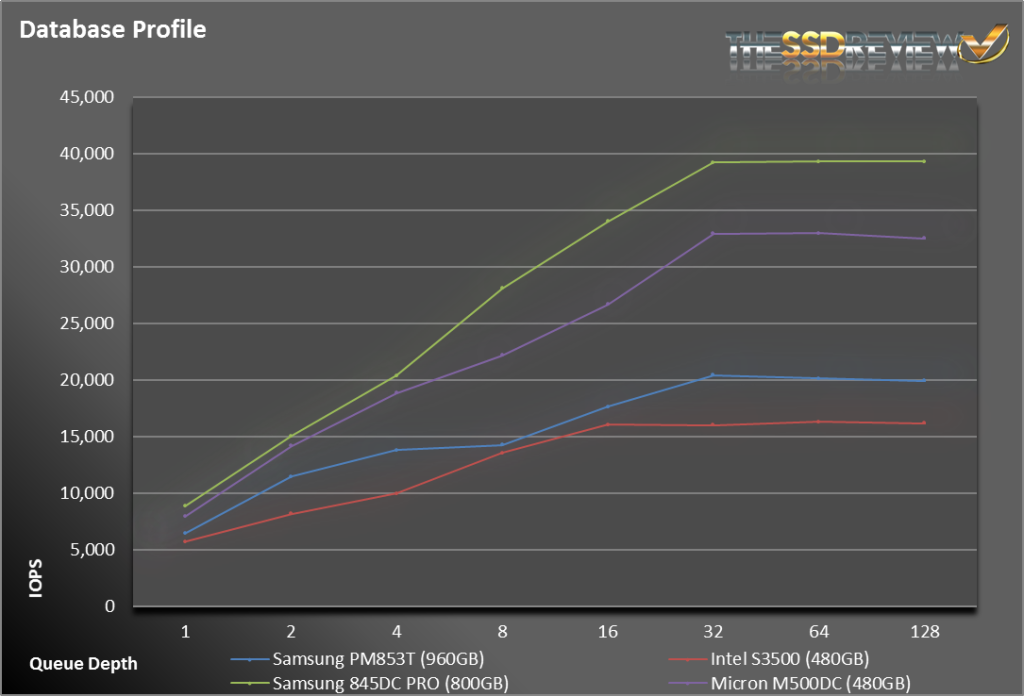SERVER PROFILES
While synthetic workloads do a great job of testing the underlying technology and reporting easy to understand results, they aren’t always indicative of how the drive will be used by the end user. Workloads that simulate enterprise environments try to bridge that gap without being overly complex.
The database profile is 8K transfers, and 67% percent of operations are reads.
In our database profile testing, the PM853T did well against the Intel offering but was no match for the M500DC and 845DC PRO, which offer 3-5x the raw random write performance.
The database profile test where we saw a stark contrast between the 845DC EVO and the PM853T. It looks as though the PM853T traded some low queue depth performance for a higher maximum total. We reran the tests multiple times and recorded the same results. This may be another case where the changes in firmware to address different enterprise use-cases changed the results we received.
The next two profiles do not show the 845DC EVO because the results were nearly identical.
The fileserver profile is based on an 80% read/20% write mix. Its made up of blocksizes from 512 to 64K, each making up a different percentage of the access pattern. The pattern is: 512 bytes=10%, 1k=5%,2k=5%, 4k=60%, 8k=2%, 16k=4%, 32k=4%, 64k=10%.
With the fileserver profile, the same general trend occurred. Both the fileserver and database profile just have too many write operations for the PM853T to match the big boys.

The webserver profile is similar to the fileserver profile, but has some additional 128K and 512K accesses thrown in for good measure. Additionally, the profile is 100% reads.
Just as with the 845DC EVO, the PM853T is at the top of the charts. Only its big brother, the 845DC PRO, can come close to matching it.
That’s really the point of the 845DC EVO and the PM853T; great read performance and good enough write performance so that the drive doesn’t get bogged down during occasional write operations.
FINAL THOUGHTS
The release of the 845DC EVO was an important mark for Samsung. The general public was wary of using TLC in the consumer space, let alone the enterprise space. The public perception of TLC NAND has not matched our experience. In fact, these products have performed extremely well for their given use-case.
Even though we spent a lot of time comparing and contrasting the PM853T and 845DC EVO, they are really just slightly different variations of the same product. Automotive journalists might call this ‘badge engineering’, where a single product is slightly tweaked to meet a certain market, such as the case with Chevy and GMC, or Honda and Acura. In this case, you have different divisions of Samsung lightly messaging a base product for a different use-case.
So, if you are sold on buying a Samsung enterprise SSD, you have to comb through the fine details to pick the drive that is right for you. In our opinion, one of the biggest difference is the warranty period. The PM853T comes with a 3 year warranty versus 5 years for the 845DC EVO. Depending on the upgrade cycle of your company, that could be a huge issue. But, with the PM853T, you get another 10C of operating temperature. Typically, with electrical components, you get a de-rating curve based on temperature. By running at higher temps for longer periods of time, you are taking life out of the product.
One of the biggest pieces of feedback that we get from our readers is that it is almost impossible to buy Samsung enterprise drives. The 845DC line was meant to address that issue and from what we have observed online, it has. The PM853T is a drive that will be hard to procure in small quantities, just as the previous PM and SM products from Samsung.
With that said, the PM853T is an excellent SSD. In read-focused environments it consistently outperforms similar SSDs. Combine that with a competitive pricing scheme and you have a winner. If we had to choose, though, we would take the 845DC EVO with its 5 year warranty and wide availability over the minor changes in the PM853T.
 The SSD Review The Worlds Dedicated SSD Education and Review Resource |
The SSD Review The Worlds Dedicated SSD Education and Review Resource | 

Thank you for the thorough review. Also: dem charts and graphs! Very helpful. The price point combined with the performance and current gen tech put this particular drive in my sights. Well written.
Thanks Drew, I appreciate it.
Hmm, seeing how this is using 19nm TLC, there just might be a chance this is losing read performance over time aswell…
No point buying this drive until it has been tested for at least a few weeks with ‘old data’.
Samsung TLC nand is not reliable at least from a performance standpoint currently. If and when a firmware update is available and users can test longer term results, then this drive may be a consideration.
Is my math off, or does the drive have weak write endurance? 78TB for the 240GB model, 158TB for the 480GB model & 315TB for the 960GB model? That’s basically consumer level?